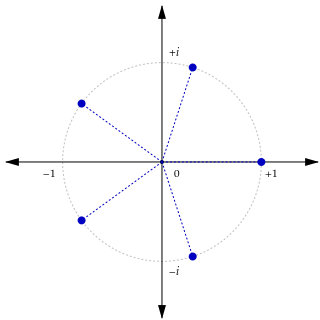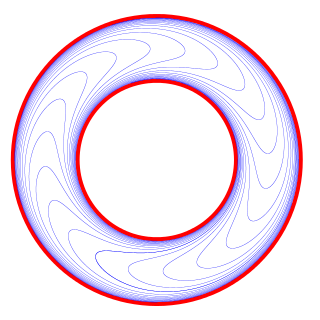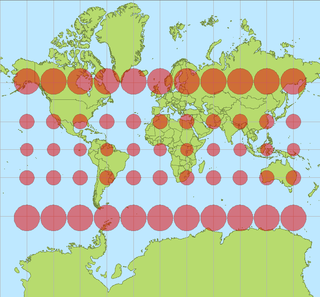
In mathematics, a diffeomorphism is an isomorphism of smooth manifolds. It is an invertible function that maps one differentiable manifold to another such that both the function and its inverse are smooth.

In the mathematical field of topology, a homeomorphism, topological isomorphism, or bicontinuous function is a continuous function between topological spaces that has a continuous inverse function. Homeomorphisms are the isomorphisms in the category of topological spaces—that is, they are the mappings that preserve all the topological properties of a given space. Two spaces with a homeomorphism between them are called homeomorphic, and from a topological viewpoint they are the same. The word homeomorphism comes from the Greek words ὅμοιος (homoios) = similar or same and μορφή (morphē) = shape, form, introduced to mathematics by Henri Poincaré in 1895.

In mathematics, an isomorphism is a structure-preserving mapping between two structures of the same type that can be reversed by an inverse mapping. Two mathematical structures are isomorphic if an isomorphism exists between them. The word isomorphism is derived from the Ancient Greek: ἴσος isos "equal", and μορφή morphe "form" or "shape".
In mathematics, an embedding is one instance of some mathematical structure contained within another instance, such as a group that is a subgroup.

In mathematics, a foliation is an equivalence relation on an n-manifold, the equivalence classes being connected, injectively immersed submanifolds, all of the same dimension p, modeled on the decomposition of the real coordinate space Rn into the cosets x + Rp of the standardly embedded subspace Rp. The equivalence classes are called the leaves of the foliation. If the manifold and/or the submanifolds are required to have a piecewise-linear, differentiable, or analytic structure then one defines piecewise-linear, differentiable, or analytic foliations, respectively. In the most important case of differentiable foliation of class Cr it is usually understood that r ≥ 1. The number p is called the dimension of the foliation and q = n − p is called its codimension.
In mathematics, specifically linear algebra, a degenerate bilinear formf(x, y) on a vector space V is a bilinear form such that the map from V to V∗ given by v ↦ is not an isomorphism. An equivalent definition when V is finite-dimensional is that it has a non-trivial kernel: there exist some non-zero x in V such that
In mathematics, in the subfield of geometric topology, the mapping class group is an important algebraic invariant of a topological space. Briefly, the mapping class group is a certain discrete group corresponding to symmetries of the space.
In mathematics, Thurston's classification theorem characterizes homeomorphisms of a compact orientable surface. William Thurston's theorem completes the work initiated by Jakob Nielsen (1944).
In mathematics, the Teichmüller space of a (real) topological surface , is a space that parametrizes complex structures on up to the action of homeomorphisms that are isotopic to the identity homeomorphism. Teichmüller spaces are named after Oswald Teichmüller.

In mathematics, a differentiable manifold is a type of manifold that is locally similar enough to a linear space to allow one to do calculus. Any manifold can be described by a collection of charts, also known as an atlas. One may then apply ideas from calculus while working within the individual charts, since each chart lies within a linear space to which the usual rules of calculus apply. If the charts are suitably compatible, then computations done in one chart are valid in any other differentiable chart.
In mathematics, structural stability is a fundamental property of a dynamical system which means that the qualitative behavior of the trajectories is unaffected by small perturbations.

In cartography, a Tissot's indicatrix is a mathematical contrivance presented by French mathematician Nicolas Auguste Tissot in 1859 and 1871 in order to characterize local distortions due to map projection. It is the geometry that results from projecting a circle of infinitesimal radius from a curved geometric model, such as a globe, onto a map. Tissot proved that the resulting diagram is an ellipse whose axes indicate the two principal directions along which scale is maximal and minimal at that point on the map.
In mathematics, two functions are said to be topologically conjugate to one another if there exists a homeomorphism that will conjugate the one into the other. Topological conjugacy is important in the study of iterated functions and more generally dynamical systems, since, if the dynamics of one iterated function can be solved, then those for any topologically conjugate function follow trivially.
In the mathematical subject of geometric group theory, a train track map is a continuous map f from a finite connected graph to itself which is a homotopy equivalence and which has particularly nice cancellation properties with respect to iterations. This map sends vertices to vertices and edges to nontrivial edge-paths with the property that for every edge e of the graph and for every positive integer n the path fn(e) is immersed, that is fn(e) is locally injective on e. Train-track maps are a key tool in analyzing the dynamics of automorphisms of finitely generated free groups and in the study of the Culler–Vogtmann Outer space.
In mathematics, the mapping torus in topology of a homeomorphism f of some topological space X to itself is a particular geometric construction with f. Take the cartesian product of X with a closed interval I, and glue the boundary components together by the static homeomorphism:
In mathematics, a Haefliger structure on a topological space is a generalization of a foliation of a manifold, introduced by André Haefliger. Any foliation on a manifold induces a Haefliger structure, which uniquely determines the foliation.
In mathematics, and more precisely in topology, the mapping class group of a surface, sometimes called the modular group or Teichmüller modular group, is the group of homeomorphisms of the surface viewed up to continuous deformation. It is of fundamental importance for the study of 3-manifolds via their embedded surfaces and is also studied in algebraic geometry in relation to moduli problems for curves.
In mathematics the Thurston boundary of Teichmüller space of a surface is obtained as the boundary of its closure in the projective space of functionals on simple closed curves on the surface. It can be interpreted as the space of projective measured foliations on the surface.
In mathematics, the Douady–Earle extension, named after Adrien Douady and Clifford Earle, is a way of extending homeomorphisms of the unit circle in the complex plane to homeomorphisms of the closed unit disk, such that the extension is a diffeomorphism of the open disk. The extension is analytic on the open disk. The extension has an important equivariance property: if the homeomorphism is composed on either side with a Möbius transformation preserving the unit circle the extension is also obtained by composition with the same Möbius transformation. If the homeomorphism is quasisymmetric, the diffeomorphism is quasiconformal. An extension for quasisymmetric homeomorphisms had previously been given by Lars Ahlfors and Arne Beurling; a different equivariant construction had been given in 1985 by Pekka Tukia. Equivariant extensions have important applications in Teichmüller theory, for example they lead to a quick proof of the contractibility of the Teichmüller space of a Fuchsian group.
In the mathematical subject geometric group theory, a fully irreducible automorphism of the free group Fn is an element of Out(Fn) which has no periodic conjugacy classes of proper free factors in Fn. Fully irreducible automorphisms are also referred to as "irreducible with irreducible powers" or "iwip" automorphisms. The notion of being fully irreducible provides a key Out(Fn) counterpart of the notion of a pseudo-Anosov element of the mapping class group of a finite type surface. Fully irreducibles play an important role in the study of structural properties of individual elements and of subgroups of Out(Fn).








